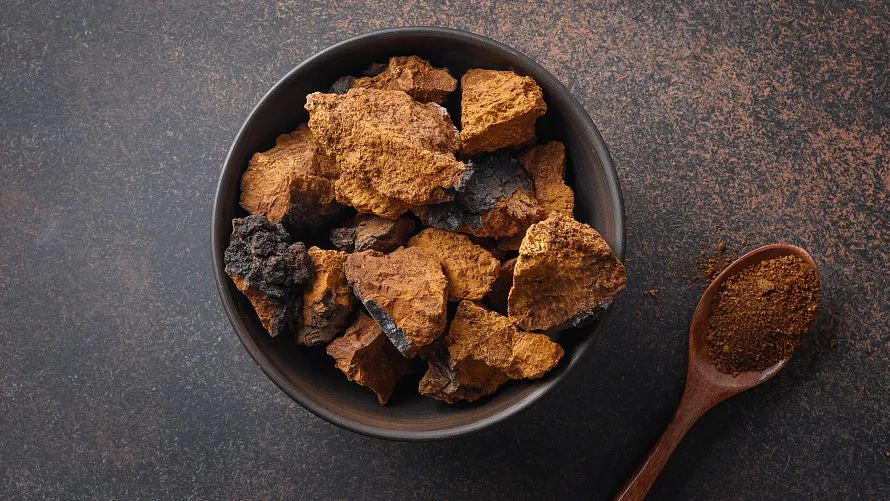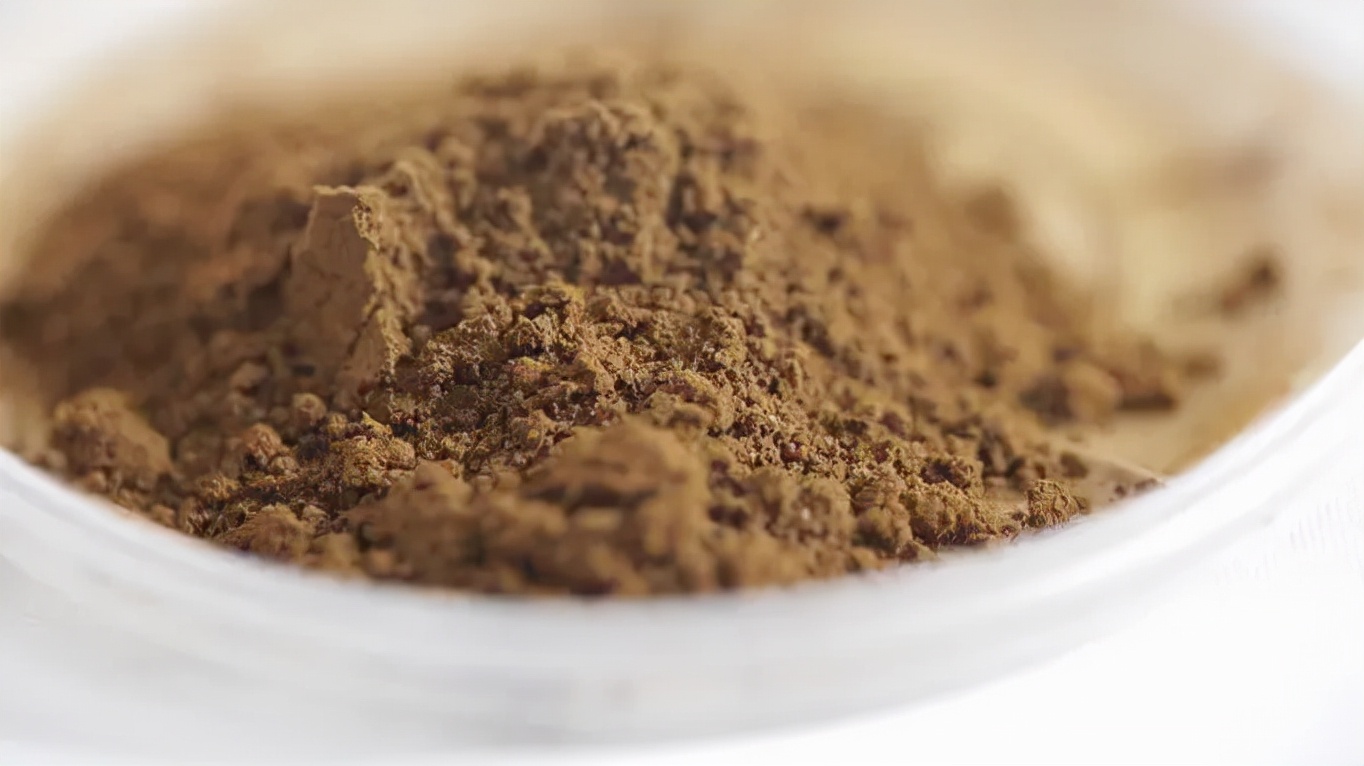Chaga mushroom, also known as Inonotus obliquus, is a resilient parasitic fungus on birch, silver birch or alder trees, mainly distributed in cold regions such as Siberia, Russia, North America, Poland, Japan Hokkaido, North Korea, and northeast China. In Siberia folks, Chaga mushroom is widely consumed to fight against the hepatitis C virus, and prevent cancer, cardiovascular and cerebrovascular diseases, and stomach and esophageal diseases. Chaga is known for its high ORAC score and immune-boosting properties, it can reduce inflammation, and fatigue and boost mental sharpness and is also beneficial for autoimmune conditions like rheumatoid arthritis and lupus.
Chaga has been described as the “King of Medicinal Mushrooms” and “The Immune-Boosting Superfood” and is known to be rich in phenolic compounds that contain strong antioxidant activity. Chaga extract is rich in very potent phytochemicals including polysaccharides, betulinic acid and triterpenes and phenolic compounds. It is also high in minerals, vitamins, and amino acids. The main active ingredient of Chaga mushroom include:
- Polysaccharides and beta-glucans: Except glucose, mannose and galactose, the most important component of Chaga mushroom is the crude polysaccharide, which appears light coffee color, tasteless, soluble in water, but insoluble in organic solvents.
- Melanin: Studies have shown that there is abundant melanin in natural Inonotus obliquus. Through the analysis of its physical and chemical properties and structure, the melanin in natural Inonotus obliquus is catechol, a phenolic pigment with high molecular weight.
- Lignin: Lignin is a water-soluble lignin derivative with high molecular weight, which can inhibit the activity of HIV protease, which is different from pure lignin molecules.
- Alcohols and terpenoids: Polish scholar Ludwiezak et al. isolated a white acicular crystalline unsaturated diol compound from theInonotus obliquus for the first time and named this newly discovered compound as Inotodiol. In addition, some saponins that play pharmacological functions regularly were also found in the Chaga mushrooms.
To extract the chaga mushroom, there are few common methods you can use. Here are the main extraction methods for chaga mushrooms:
Hot Water Extraction
Chaga powers made using the hot water extraction method are extra potent. This is the most common method used to extract beneficial compounds from Chaga mushrooms. Follow these steps:
- a.Start by grinding the dried chaga mushroom into a fine powder.
- b.Place the powder in a pot and add water. The ratio of Chaga to water can vary, but a general guideline is to use 1 part chaga to 15-30 times the amount of water.
- c.Bring the mixture to a boil, and then reduce the heat to a simmer. Let it simmer for at least one hour, but longer extraction times (up to four hours) can yield stronger extracts.
- d.After simmering, strain the liquid using a fine-mesh strainer or cheesecloth to remove the chaga mushroom residue.
- e. The resulting liquid is your chaga mushroom extract, which can be consumed as is or used in various recipes and preparations.
The mushrooms would best be prepared through hot water extraction to avoid losing the beneficial beta-glucans to alcohol. However, when preparing a chaga tincture using the hot water method, many of the beneficial soluble components will be lost due to boiling. Excessive heat will destroy many of the beta-glucans and other water-insoluble components like phytosterols and betulinic acid. These non-water soluble compounds cannot be easily extracted with water, so are typically separated out through alcohol extraction using ethanol. This creates a liquid extract that contains the alcohol-soluble components of the mushroom, such as terpenes, sterols and flavonoids.
Dual Extraction
Dual Extraction (Alcohol and Water): This method involves using both water and alcohol to extract the active constituents from the Chaga mushroom. Dual extraction helps to extract a wider range of compounds, including those that are not soluble in water alone. The alcohol helps to draw out the water-soluble phytochemicals from the plant, including polysaccharides and betulinic acid. These mushroom species are well suited for dual extraction – first making an alcohol-based extract and then using a hot water decoction to extract the remaining material. The resulting liquids can then be combined to create a tincture that contains the benefits of both alcohol-soluble and water-soluble chemicals. Follow these steps:
- Start by grinding the dried chaga mushroom into a fine powder.
- Place the powder in a jar and cover it with a high-proof alcohol, such as vodka or grain alcohol. Make sure the chaga is fully submerged.
- Let the mixture steep for at least two weeks, shaking it occasionally.
- After the alcohol extraction period, strain the liquid through a fine-mesh strainer or cheesecloth to remove the chaga residue.
- Take the strained chaga mushroom residue and follow the steps for hot water extraction mentioned earlier to extract the water-soluble compounds.
- Finally, combine the alcohol and water extracts, and you have your dual-extracted chaga mushroom extract.
Ultrasonic – microwave extraction method
Chaga mushroom powder 40 mesh. Ethanol solution with a volume fraction of 80% was used for reflux twice at 70℃ for 3h each time to effectively remove part of the alcohol-soluble substance, then centrifuged at 1000r/min for 20min to remove the supernatant, precipitated and vacuum dried at 60℃ to obtain the pretreatment of velvet betula powder.
- The pre-treated Chaga mushroom powder sample was placed in a 250ml glass extraction container closely bonded with a 50W ultrasonic transducer. With water as the solvent, the transducer was stuck into the center bottom of the microwave chamber to generate direct ultrasonic vibration.
- The extraction vessel is connected to a spherical condensate tube through a conversion joint, through which heated solvent vapor is cooled and returned to the sample vessel. Set a certain extraction time and microwave radiation power, turn on the instrument, after the extraction is completed, place it for cooling for a while and take it out. Then centrifuge the extraction solution at 1000r/min for 10min, combine the clear solution, and concentrate it under pressure. Adjust it to 80% alcohol content with industrial alcohol, and centrifuge it after standing for several hours. Then freeze-dried to obtain crude polysaccharide.
In order to determine the optimum process conditions of ultrasonic-microwave assisted extraction of polysaccharides from Chaga mushroom, response surface analysis was used to optimize the parameters of ultrasonic-microwave extraction. On the basis of single factor pretest, extraction time (15min, 20min, 25min), solid-liquid ratio (1:15, 1:20, 1:25) and microwave power (55W, 85W, 115W) were selected as factors, and analyzed by SAS software system. A quadratic regression equation with three factors and three levels was designed to fit the functional relationship between the factors and the index (response value). In other words, the optimum conditions were as follows: extraction time 18.45 ~ 24.50min, microwave power 88.3 ~ 96.7W when the fixed solid-liquid ratio was unchanged at 1:20.
Traditional hot water extraction is generally used in industrial applications, but water extraction has the disadvantages of long extraction time and high temperature, and more Chaga mushroom extract manufacturers use hot water and alcohol dual extraction. In addition, supercritical low-temperature extraction, ultramicro wall breaking and grinding, and low-temperature vacuum drying processes are increasingly widely used because of higher yield and purity.
- Dandelion Extract: What It Is, Benefits, Uses and Side Effect - April 23, 2024
- Is Berberine Extract Help For Weight Loss? - April 11, 2024
- Why Is Pysllium Husk Powder A Popular Meal Replacement Ingredient? - April 3, 2024




